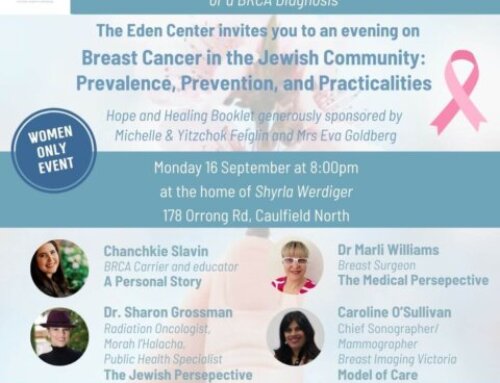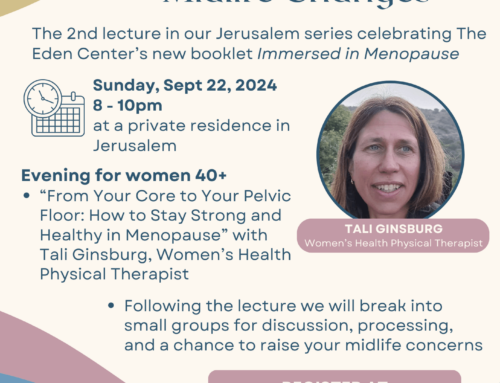
The constant transition between times of separation during niddah and times of physical togetherness can be very challenging. As a life coach and kallah teacher, I often encounter women and couples who become overwhelmed with this constant transition, and this then translates into frustration with observance of halakha. Observance, and halakha itself, become a burden rather than a tool for growth.
Recently, a fellow kallah teacher reached out asking for guidance to give over to her kallot, on how to alleviate the difficulties of this transition, so that they would not share the experience of overwhelm and frustration of so many other women before them. As a life coach for women’s wellbeing, working with young adults as well as married women and moms, overwhelm and frustration are common, though generally unwanted, visitors to my clinic. As a kallah teacher I have implemented my knowledge and skills of life coaching in order to handle exactly this quandary – what tools can we provide our kallot so that the cycle of developing overwhelm and frustration, on many aspects of observance, does not repeat itself? What are the fundamental mindsets that any married woman, and any couple, should have in order to positively cope with these times of transition, and shift their thinking about times of separation?
Here are a few key points I find helpful to keep in mind. The good news is, it is never too late to learn these tools no matter what stage of marriage you are in.
1. We are trained to view marriage as a WE – a unity of two individuals who become one. This is theoretically wonderful and also potentially detrimental. It is important to remind ourselves, especially as women, that the WE is made up of two I’s. The WE is strong because of each individual I and what each of us brings to the table. Indeed, this is perhaps the intention hinted to in the third and fourth of the sheva brachot. The third bracha, yotzer ha’adam (“Creator of Man”), celebrates each individual soul created, while the fourth recognizes that only when individuals are joined together, when they each bring the uniqueness of themselves, will they succeed in creating a binyan adei ad (“everlasting edifice”). The cycle of taharat hamishpacha, beyond its halakhic requirements, retains space for the I within the WE by implementing times of physical separation and thereby broadening the space within which the individual can flourish.
I encourage you (and your spouse) to use the time when you are physically separated to strengthen your I. Obviously, without completely ignoring the WE. It is a time of opportunity to put effort into your studies or your job. It is a great time for a night out with your respective friends, a pampering evening, or a chance to work on your current hobby or the one you have always dreamed of having time for. You are ensuring that you do not lose who you are within the marriage (and then have to come to me for professional help 😊) but rather develop yourself while simultaneously developing the relationship within the marriage.
2. Physical communication is easier for many people and can be more fun than verbal communication. Sexual communication has an intimacy that verbal communication will never have. As a result, physical and sexual forms of communication are often preferred by newlyweds/couples – again, for their ease and intimacy. However, verbal communication is the only form of communication that allows for deep understanding of the individual. A sharing of ideas, explanation of emotions and experiences, and clarifications that are otherwise left to simmer as misunderstandings and inevitably evolve into arguments, are all achieved as a result of verbal communication. This renders verbal communication as both the most essential and the most challenging mode of communication for many couples.
A marriage is two individuals in flux within themselves and with each other. The only way to allow each other to truly understand the changes and flow of the individual is by working hard at verbal communication. By default, the time of physical separation cocoons a space in time to work on this hard earned, and critically important, skill.
One of the best ways of doing this is by setting a time each day for invested conversation.The investment lies not only in the time set into your busy schedules but, more importantly, the investment of sharing and listening. For some it is the sharing that is challenging. For others, the listening. Being fully present in an invested conversation is one of the greatest gifts you can give to your marriage. It may feel awkward or fake in the beginning but the rewards far outweigh the initial hesitation and inhibition.
There are many books and specialized cards available to help begin invested conversation when you are new to it and not sure what to do. But the most important aspects of invested conversation are:
- No distractions: That means leave your cellphones off, or at least out of sight.
- Active listening: Don’t just hear what the other person is saying but understand it. Notice the emotion with which it is being said, and the body language that coincides with the words.
- Always wait until the other person is finished speaking before responding. Even if it means you have to write down your ideas so you won’t forget them.
- Ask: If you’re not sure you understood something, ask for clarification.
Be curious about what the other person is saying and invest in the conversation by asking with authentic interest.
3. Though recognizing and focusing on the benefits of the time the couple is physically separated will alleviate some of the stress, it can still be emotionally challenging. The tools of self-love can help in this area. Self love is different from self-care. Self-care is crucial to general wellbeing and general stress, but not the tool needed here. Self-love relates to the physical and emotional love we provide for ourselves.
How do we provide ourselves with the physical love we NEED when the person physically closest to us cannot?
a. Hug yourself – wrap your arms tightly around yourself, massage your shoulders, sense the touch you provide and receive for yourself.
b. Ask for touch – have a designated friend or relative who hugs you when you need it. If it makes you more comfortable, you can verbally ask, or agree with them ahead of time, on how you will indicate that you can use a hug. Kids – if you have kids, and they are at home – are amazing for this. Just remember to ask for a cuddle and not demand it. You will teach your kids both the importance of asking for physical support as well as developing their physical resilience and autonomy. Remember that touch is a basic human need, and you will be a better person and therefore a better spouse/mom/neighbor/employee when you cater to that need.
c. Me/Myself – This is a simple technique which, especially when practiced over time, reduces stress and instills calm and even confidence; a sense of being held even when you’re not. Place your hands, one over the other, on your heart (center of your chest, generally just above the breasts). Take a few deep breaths directing the air towards your stomach. Breathe out very slowly until you have exhaled fully. After a few deep breaths like this, repeat to yourself the words ‘me, myself’ and gently tap your hands against your chest as you exhale. Again, deep breath into your stomach, and as you exhale repeat the words ‘me, myself’ while tapping your hands against your chest.
A similar tool is simple grounding, where one hand is placed on the heart and the other on the lower abdomen (essentially very close to or on the uterus). Deep breathing as with the exercise above will create a sense of calm and security, a sense of being held, even when that physical holding by another is not available.
Tip: Like any exercise, it may be challenging in the beginning but, with practice, you build your muscle. The more you practice these exercises regularly, the greater the benefit you will experience.
These are just a few ideas and techniques that can help you ease the transition back and forth between physical intimacy and physical distance. Transitions of any kind are challenging. The more positive you are about yourself, the more supported you are, and the more positively you can view the situation, the more you will ensure the ease and fluidity of the transition. Though this transition too can be challenging, it should not become a burden. I encourage you to consider and practice one idea shared here and evaluate the benefits you gain from it. Once you have practiced it a number of times, move on to another and evaluate the benefits once again. Continue through the various practices until you have found the ones that are right for you.
Chana Schmell is a certified Life Coach, licensed Childbirth Educator and Doula (CAPPA), certified Kallah Teacher, and Torah Educator. To discuss any of these ideas further, please be in touch here: https://www.chanaschmell.com/.








Leave A Comment